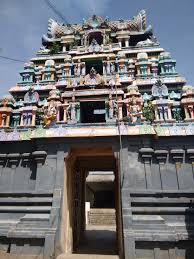Iluppaippattu Sri Neelakandeswarar Temple, Nagapattinam

Diety: Neelakandeswarar, Amman: Sri Amudhakara Valli
Temple Address: Iluppaippattu Sri Neelakandeswarar Temple, Thiru Pazha Mannippadikkarai (Iluppappattu), Manalmedu Post Via, Mayiladuthurai Taluk, Nagapattinam District, Tamil Nadu – 609 202. Tele: +91-92456 19738.
Open between: 06:00 AM to 12:00 PM and 04:00 AM to 08:30 AM
Introduction
Iluppaipattu Neelakandeswarar Temple is a Hindu temple located at Iluppaipattu in Mayiladuthurai district of Tamil Nadu, India. The place is also called as Pazhamanni Padikarai and Tirumannippadikkarai. The presiding deity is Shiva. He is called as Thiruneelakandeswarar and Padikarai Nathar. His consort is AmirthavalliIt is one of the shrines of the 276 Paadal Petra Sthalams – Shiva Sthalams glorified in the early medieval Tevaram poems by Tamil Saivite Nayanar Sundarar. Theertham (Holy water): Brahma Theertham, river Manniyaru and river Kollidam Sthala Vriksham (Sacred Tree): Iluppai tree
Puranic Significance
In ancient times, this region is believed to have been densely covered with Iluppai trees. This temple’s “sthala viruksham” is also the Iluppai tree. Hence, this place gets the name Iluppaipattu. This temple is situated on the southern banks of the river Manniyaru, also known as Subramanya river. Hence this place is also known as “Pazha Manni Padikkarai” (“pazha” meaning ancient, “Manni” relates to the river and “Padikkari” meaning river bank in Tamil).There are a few stone inscriptions here which date back to the periods of Chola King Rajaraja and some kings from the Vijaya Nagara dynasty.The historical names of this place are Madhookavanam and Pazhamanni Padikkarai. This temple is under the administrative control of the Thiruvavaduthurai Aadheenam.According to legend, during their exile, the Pandava brothers stayed in this place for some time. Duryodhana is believed to have poisoned the Brahma Theertham of this temple but Goddess Parvathy removed the poison and replaced it with celestial nectar. Thereafter, Lord Shiva is believed to have consumed the extracted poison in order to save the Pandavas. The tank is also known as “Nachupoigai” (loosely translated as poison pond). Goddess Parvathy here is praised as “Sri Amirtha Kara Valli” (“Amirtham” meaning nectar, “karam” meaning hands and “valli” meaning goddess in Tamil). It is believed that the Pandavas used to extract oil from the seeds of the Iluppai tree and used it to light lamps here. It is believed that Lord Shiva was so impressed by their meditation that he granted them darshan individually. Each one of them requested the lord that he stay back here to grace all devotees. To appease them, the lord then appeared in the form of five Shivalingams in different locations in this temple’s complex. It is believed that the Paandavas made five separate shrines for these Shivalingams. The shivalingams are named as follows – 1. Sri Neelakandeswarar with Amudhakara Valli worshiped by Dharumar, 2. Sri Padikkarai Nathar with Goddess Mangalambikai worshiped by Arjunan, 3. Sri Mahadeeswarar worshiped by Bheeman, 4. Sri Parameswarar worshiped by Nakulan, and 5. Sri Muktheeswarar worshiped by Sakadevan. As per the “Sthala Puranam” of this temple, another legend associated with this temple involves a Chola king. Once, while crossing the river Manniyaru on a boat to reach this temple, he saw an uprooted Iluppai tree floating on the river. He brought that tree to the temple and erected it here. He felt that the oil extracted from its seeds could be used to light lamps here. A beautiful sculpture depicting this incident can be seen on the outside wall of the sanctum sanctorum.It is believed that Pandavas, Lord Brahma, King Manthatha and Emperor Nalan have worshiped the lord here.
Beliefs
Devotees believe that by praying to Lord Mahadeeswarar (Shodasalingam) in this temple, they would be blessed with the 16 types of wealth (“Pathinaarum Petru” in Tamil). Devotees with an inclination to the fields of astrology and shastras can pray to Sri Muktheeswar here. Lord Muktheeswar is believed to have been worshiped by Sakadevan who is believed to be an expert in these fields. Married women can pray to Goddess Parvathy here for longevity and prosperity of their married life.
Special Features
This is one of the 276 Devara Paadal Petra Shiva Sthalams and 30th Shiva Sthalam on the northern bank of the river Cauvery in Chozha Nadu (Vadakarai). Lord Shiva in this temple is a Swayambumurthi (self-manifested). This east facing temple has two corridors and its main tower (Rajagopuram) has 3-tiers. The last consecration ceremony (Maha Kumbabishekam) took place on 30.08.2009. Other than the 5 shrines of Lord Shiva and 2 shrines of Goddess Parvathy, shrines and idols of Valampuri Vinayakar worshiped by Dhraupathi, Murugan with his consorts, Narthana Vinayakar, Dakshinamurthy, Lingothbavar, Ashtapuja (8 hands) Durgai, Chandikeswarar, Gajalakshmi, Saneeswaran, Bairavar and Suryan can be seen in the corridors.
Festivals
10-day Brahmotsavam in the Tamil month of Chithirai (April-May), Vinayakar Chaturthi in the Tamil month of Aavani (Aug-Sept),Annabishekam in the Tamil month of Aippasi (Oct–Nov), andThirukarthikai in the Tamil month of (Nov-Dec). Shivrathri in the Tamil month of (Feb-Mar), Pradosham is also observed regularly.
Century/Period/Age
1000-2000 years old
Saints and Singers
Sundarar
Managed By
Hindu Religious and Charitable Endowments (HRCE)
Best Time
10-12
Accommodation
Mayiladuthurai
Nearest Bus Station
Iluppaippattu
Nearest Railway Station
Mayiladuthurai
Nearest Airport
Trichy




